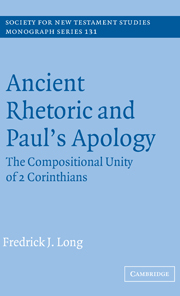Book contents
- Frontmatter
- Contents
- List of figures
- List of tables
- Preface
- List of abbreviations
- 1 An apology for the unity of 2 Corinthians
- Part 1 A survey of ancient forensic discourse
- Part 2 A rhetorical analysis of 2 Corinthians as ancient apology
- Appendix I How the peroratio (12.11–13.10) summarizes 2 Corinthians
- Appendix II Topoi for each subtype of the qualitative stasis
- List of references
- Index of biblical references
- Index of ancient authors and sources
- Subject index
1 - An apology for the unity of 2 Corinthians
Published online by Cambridge University Press: 12 November 2009
- Frontmatter
- Contents
- List of figures
- List of tables
- Preface
- List of abbreviations
- 1 An apology for the unity of 2 Corinthians
- Part 1 A survey of ancient forensic discourse
- Part 2 A rhetorical analysis of 2 Corinthians as ancient apology
- Appendix I How the peroratio (12.11–13.10) summarizes 2 Corinthians
- Appendix II Topoi for each subtype of the qualitative stasis
- List of references
- Index of biblical references
- Index of ancient authors and sources
- Subject index
Summary
Introduction and overview
Ever since Johann S. Semler's commentary on 2 Corinthians in 1776, scholars have debated its compositional unity. After Semler, a flood of partition theories followed (see the surveys of Hyldahl, 1973, Betz, 1985, and Bieringer, 1994b).
Interpreters typically assume that 2 Corinthians is a composite letter of two or more letters or letter fragments. The number of individual letters and their respective order (also in relation to 1 Corinthians) vary greatly. Scholars have held to as few as two distinct letters: chaps. 1–9 and chaps. 10–13 (e.g., Bruce, 1971). Others have argued that 2 Corinthians contains five distinct letters or fragments: 1.1–2.13 with 7.5–16; 2.14–7.4 (excluding 6.14–7.1); chap. 8; chap. 9; chaps. 10–13 (e.g., Betz, 1985; cf. Bornkamm, 1965) or more (e.g., Schmithals, 1973). Furthermore, 2 Corinthians 6.14–7.1 is considered non-Pauline material. It is standard in current scholarship to ask where to find these smaller letters and how best to understand them according to epistolary and rhetorical conventions.
Considerable confusion results when interpreting 2 Corinthians and reconstructing Paul's theology. Presently, interpreters are left to determine the meaning of parts of 2 Corinthians on the basis of hypothetically reconstructed letters placed in a reconstructed chronological sequence in order to understand the reconstructed situation and Paul's theological response(s). Moreover, if 2 Corinthians is not understood as a unity, an ambiguity arises concerning how the church can adequately appropriate this composite letter in its final form (see Kurz, 1996, who attempts to overcome this dilemma through a canonical–critical approach).
- Type
- Chapter
- Information
- Ancient Rhetoric and Paul's ApologyThe Compositional Unity of 2 Corinthians, pp. 1 - 14Publisher: Cambridge University PressPrint publication year: 2004



